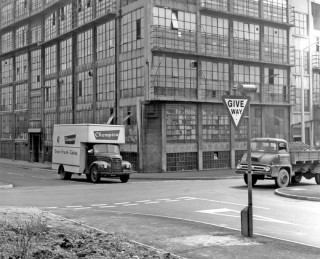George Cunningham: Working Life ~ Part 2
New Beginnings
Researched and written by Gemma Clarke
George stopped working at Cooper Brothers due to bomb damage at the factory, and the fact that he was under eighteen which was when he would have been paid an adult wage. That is when his working life took him to work at Viner’s Ltd. and the high building picture shown below on the right, shows where the factory would have been.
The End of Working at Cooper Brothers
‘It became evident, even at Cooper Brothers, that the war was getting serious. The Jerries invaded Greece and Yugoslavia, the production of the tea and sugar containers were terminated, and Mr Beardsall told me, ‘Mr Little says that you and me have to work on the machines in the press shop.’ My heart fell, but he continued, ‘If you want, while you’re still sixteen, you are free to get another job, but when you reach seventeen, you can be directed anywhere by the Government.’ He also informed me that the College of Art had been so badly damaged that the silversmithing class had been discontinued for the foreseeable future. I still had the child’s cup and bowl, but the unfinished plate that was to complete the set lay under tons of rubble.’
New Opportunities
‘As I walked home I didn’t feel too bad about this new phase of my career. At sixteen, with all the optimism of youth, the world was my oyster, just waiting to be opened. When I told Dad about my situation, he chuckled, ‘That’s funny, I called into Arthur Rogerson’s for a drink and Harry Benton, an old pal of mine, happened to mention that he was looking for a lad to work for him and learn die-sinking.’ Mam looked worried at this remark and queried, ‘Won’t the dye get on our Georgie’s chest? You know how delicate he is.’ On being reassured that this would not be the case, Dad said that he would contact Harry Benton and arrange for an interview with him.’
A New Career
‘This he did, and a few days later, I walked up Clarence Street to the time house entrance of Viner’s in Bath Street. I was greeted by a one-armed old soldier, now a timekeeper, who informed me that his name was Bert Denham, and was then escorted by him to the workshop of Harry Benton, master die-sinker.’
The Workshop
‘This imposing hive of industry was a narrow, partitioned-off corner of the press shop. One side was taken up by shelves full of dies and at the other, near the windows, a bench ran the full length of the shop. A foot-treadled grindstone in an iron trough of water was the only piece of machinery, and the heating was supplied by a small oil drum, punctured with holes and placed over a gas ring on the floor. After coming through the press shop and being frightened by the thudding steel monsters, the sight of this highly-sophisticated equipment cheered me up, and I felt that I could cope.’
P. 72, Chapter 15, More George! (courtesy of The Hallamshire Press Limited).
1945 at Viner’s
‘The first few weeks of 1945 were bitterly cold, with thirty degrees of frost. Fuel was short, but an unexpected bonus was open lorries, full of a black sludge-like cargo of slurry, which was the residue from coal-washing plants. One of the lorries pulled up outside Viner’s and I dashed out and filled two buckets full for a tanner. Back in the die shop, I moulded the mess into balls as big as an orange. These I placed on a wire grill over the gas ring and left them to dry. They burnt feebly but at least with a little warmth when I took them home. Nearly every house in the district used them and for days a pall of dark smoke hung over the streets. In spite of hardship, there was a general feeling of relief as if everyone sensed that the long ordeal would soon be over.’
P. 132, Chapter 28, More George! (courtesy of The Hallamshire Press Limited).
Interview with George
George was stood outside Viner’s however, at the time the video was taken the factory had been demolished and George was stood next to a pile of rubble on one side with the dual carriageway on the other.
He was asked about the factory itself:
‘Viner’s, well I came to Viner’s during the war, 1941 and it had suffered a bit of bomb damage but nothing like this [gesturing to the pile of rubble that remained] and err I worked here for a few years until 1948 then I left and I went outworking, […] when I came back probably 1957. I worked until it finished, in fact I think I put the lights out on Christmas Eve, three years ago, and err this is what its come to, once one of the biggest cutlery firms in Europe.’
Mr Roy Newman, George Cunningham’s Life, Paintings and Interests, Dinnington & District Historical Society, www.dinningtonhistory.co.uk/products, Reference copy available at Sheffield Local Studies Library.











No Comments
Add a comment about this page